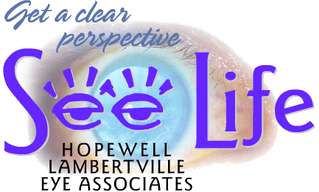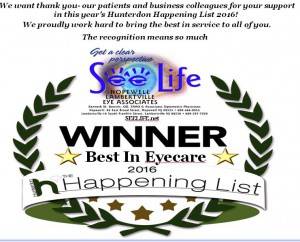Eye Healthy: Good Eating & Good Snacking
Eat Well - See Well from Hopewell Lambertville Eye (www.seelife.net) :
Did you know diet and exercise are important to maintaining your eye health? Maintaining a normal body weight can help decrease your risk for developing diabetes, cardiovascular disease, cancer , cognitive function and many other chronic conditions that affect your eyes such as macular degeneration, cataracts, glaucoma, diabetic retinopathy, dry eye….. Avoid binge eating and processed snack foods. Proper balanced nutrition and healthy snacking throughout the day can make you feel more energetic, productive and loose and maintain proper weight.
So what are you to do at 3pm or while watching the game or movie, when hunger hits you and the vending machine is calling your name? Snacking should be fun, enjoyable, and satisfying but does not have endanger your health as do processed snacks. You have alternatives to the processed snacks that are better for your eyes, heart, brain and body health while giving you high level of taste and enjoyment and proper nutrition and won’t effect the waste-line.
NUTRIENTS THAT ARE IMPORTANT FOR YOUR EYES
- Vitamin A (colorful vegetables, lean meats- poultry)
- Beta carotene (colorful vegetables)
- Zinc (dairy, lean meats- poultry)
- Vitamin C (fruits)
- Vitamin E (Seeds, Nuts, peanuts, colorful peppers, Wheat germ oil. , green leafy)
- Omega-3 (fresh water fish, eggs)
- Lutein (green leafy vegetables)
- Zeaxanthin (green leafy vegetables)
The following are easy snack ideas to satisfy your afternoon cravings in a healthy way.
Colorful Vegetables
As an example - eating carrots don’t directly improve your eyesight, but did you know they’re great for the skin and helping the body fight infection? Carrots contain beta-carotene, a substance that the body converts to vitamin A, an important nutrient for eye health. An extreme lack of vitamin A can cause blindness. Vitamin A can prevent the formation of cataracts and macular degeneration, the world’s leading cause of blindness. In addition to beta-carotene, carrots also contain lutein, an antioxidant. Foods rich in lutein have been found to increase pigment density in the macula. The greater pigment density in the macula, the better protected your retina is and the lower your risk for macular degeneration.
Like egg yolks, carrots have vitamin A and also beta carotene. Vitamin A and beta carotene help the surface of the eye and can also help prevent eye infections and other serious eye conditions such as macular degeneration, retinal disease and diabetic retinopathy.
Carrots are easy to eat on the go. Julianne whole carrots or keep a bag of baby carrots handy for an afternoon or evening snack. Toss them in salads and soups for some added nutrition, or shred them up and add them to muffin or pancake batter. Or how about a vegetable platter with Red bell peppers., Tomatoes, Radishes., Carrots, Orange bell peppers, Yellow bell peppers, Baby corn, Celery complemented with a yogurt or sour cream type dip with dill. [i]

Vegetable - Fruits - Grapes - Bioflavonoids – Red Wine
Foods rich in bioflavonoids include celery, parsley, herbs, peppers, berries, pomegranates, plums, red wine, grapes, citrus fruits, soybeans, legumes, onions, leeks, Brussels sprouts, kale, broccoli, tea, beans, apples and cocoa
Red - White Grapes – Red Wine are flavonoid-rich interiors help protect cells from oxygen damage. Eating a grape-enriched diet has a protective effect on retinal structure and function. Eating more grapes brings down inflammatory protein levels and increases the number of protective proteins in the retina. The extract from the grapeseed contains phytochemicals that are beneficial to the eyes. Aside from those benefits, it also contains antihistamines and antioxidants which promote eye care. They’re also filled with antioxidants that fight heart disease and the development of cancer cells. 1 1/2 cups, grapes only contain 85 calories and no fat.
Instead of beer consider red wine. Why? Red wine, in moderation, has long been thought of as heart healthy. The alcohol and certain substances in red wine called antioxidants may help prevent coronary artery disease, the condition that leads to heart attacks. Part of the benefits are related to the antioxidants in red wine may increase levels of high-density lipoprotein (HDL) cholesterol (the "good" cholesterol) and protect against cholesterol buildup.
Resveratrol, found in the grape skin, is the main biologically active polyphenol within red wine. Owing to its vascular-enhancing properties, resveratrol may be effective in the microcirculation of the eye, thereby helping prevent ocular diseases such as age-related macular degeneration, diabetic retinopathy, and glaucoma.[ii] [iii] [iv]
Almonds - Nuts
Unsalted almonds are high in the right kind of fat: monounsaturated that helps reduce cholesterol levels. They’re also loaded with protein, fiber, and folic acid. Try sprinkling them on a favorite salad or in low-fat yogurt. Approximately 30 nuts come to just over 160 calories and 14 fat grams. Almonds, like other nuts and seeds, are generally good for eye health. Almonds contain vitamin E. This vitamin guards against unstable molecules that target healthy tissue. Consuming regular amounts of vitamin E can help prevent age-related macular degeneration as well as cataracts. You should aim for about 22 international units (IU), or 15 mg of vitamin E a day. One serving of almonds is about 23 nuts, or ¼ cup, and has 11 IU. Other nuts and seeds that contain vitamin E include sunflower seeds, hazelnuts, and peanuts.
Popcorn
Popcorn is a very traditional snack but also is promotes eye health. Popcorn contains lutein, beta-carotene, and zeaxanthin, all of which can boost the health of your eyes. Select the 94% fat-free popcorn packets unsalted, add your own slat to taste and avoid the extra processed butter – add your melted butter for taste. Since it’s a whole- grain food, popcorn is a high-quality carbohydrate source offering fiber and a minimal 110 calories and 2 fat grams per six popped cups.
Dips and Salads
Legumes are plants, pods and seeds. They refer to things like peas and beans (for example: green beans, broad beans, snake beans). So things like chickpeas, black-eyed peas, kidney beans, mung beans, and lentils (yellow, red, brown and green). These can all be made into a tasteful snacking dips for your vegetables. Not only are legumes are a protein powerhouse and an excellent source of fibre, they are also full of omega-3. These are used in dips like hummus, or in Mexican stews and Mediterranean salads.
Avocado - Guacamole: Setting aside the obvious delicious flavor of avocado, it actually provides nutrients that promote good eye health! The reason avocado is good for your eyes is the high amount of lutein that is found in it. A single ounce of avocado contains 80 micrograms of lutein—most lutein supplements only give you 10 mcg
How about various options of spices – berries o teas that are eye healthy when making your dips and drinks.
Besides being an antioxidant, turmeric is also beneficial to the eyes. Turmeric reduce the presence of oxidation in the eye's lens. As a result, the eye's lens remains sharp and accurate. Additionally, turmeric contains an ingredient known as Curcumin, which promotes healthy eyes. Researchers have found that this compound is effective in treating dry eye syndrome. Excellent in dips such as Turmeric-Ginger Tahini Dip
Fennel 'The herb of sight'. This herb contains Vitamin A, Iron, and nutrients that slow down cataract progression and promote vision wellness. Grind 1 cup almonds, fennel, and sugar to powder form. Add a few tablespoons of this powder to a glass of milk. Drink before going to bed. Continue this routine for 40 days to see the difference in your vision.
Berries are high in antioxidants called Anthocyanins. Blueberry and cranberry, their botanical siblings, also contain such substances. In the 1940s, during the world war-II, Royal Air Force pilots reported of improved vision when they ate bilberry jam. Support retinal photoreceptor recovery and improved night vision.
Green Tea bind Free radicals cause so-called oxidative damage. It is the underlying factor of many chronic diseases, including glaucoma, and cataracts. Antioxidants from green tea mop up the free radicals. Polyphenols in green tea protect retinal cells from UV light damage. UV light contributes to cataracts and macular degeneration. [v] [vi] [vii]
Kale (Kale Chips)
Kale is known as a superfood by many because it contains so many important vitamins, nutrients, and minerals. It’s extremely good for eye health. Kale has the antioxidants lutein and zeaxanthin, also found in eggs and other foods. These nutrients may help to prevent serious eye conditions such as age-related macular degeneration and cataracts. Lutein and zeaxanthin aren’t made in the body, so you have to incorporate them into your diet. A 100 gram serving of kale, which is about 1 ½ cups, contains 11.4 mg of lutein, and it’s recommended you get 10 mg per day. Other vegetables high in lutein are red peppers and spinach.
Kale can be made into snack chips. First wash the leaves, then tear them into small pieces; toss it in olive oil, and bake it 20 minutes or so, until the kale gets crispy. You can season them with a light sprinkle of salt. You can also sauté kale for a side dish or serve it in a salad.
Imagine being able to munch as many crunchy snacks as you want while you're binging that show you love without feeling guilty later. That's the beauty of these homemade baked kale chips. Made by quickly tossing together three simple ingredients – fresh kale, olive oil, and flaked sea salt – and baked low and slow for only 20 minutes, these crispy kale chips are easy to make, there are no mystery additives, and even fussy eaters snap them up. https://www.allrecipes.com/recipe/176957/baked-kale-chips/
Dairy Products: Healthy Shakes
Dairy products such as milk and yogurt can be good for the eyes. They contain vitamin A as well as the mineral zinc. Vitamin A protects the cornea while zinc helps bring that vitamin to the eyes from the liver. Zinc is found throughout the eye, especially the retina and choroid, which is the vascular tissue that lies under the retina. This important mineral helps with night vision as well as the prevention of cataracts. Dairy from grass-fed cows provides the most benefits.
Dairy can be consumed throughout your day. You can drink a glass with a meal or enjoy it in coffee and tea, or breakfast cereal. Yogurt is a healthy option for breakfast or as a snack.
Smoothies with Nuts are also rich in vitamin E and omega 3 fatty acids. Almonds, cashews, peanuts, walnuts, pistachios and brazil nuts are all great for your eyesight. Enjoy a small handful daily as your afternoon pick-me-up or add them to your morning smoothie or granola mix together with your choice of seeds. The ultimate smoothie – chocolate almond milk and /or yougart (fruit, palin or vanilla) , banana, almond butter, agave (sweetening) – ice. Talk about a energy boost that’s good for your eyes.
Dark Chocolate:
Eating dark chocolate (Serving Size:1.7 oz) can enhance visual performance. It is believed the cocoa in dark chocolate may increase blood flow to the brain and retina. This in turn can improve motion detection and improve the capability to see letters of low contrast. Dark chocolate also contains lutein and zeaxanthin which help to reduce your risk of getting common eye diseases like cataracts and age related macular degeneration as well as supporting the cardiovascular benefits. How about a dark Chocolate covered almonds
Hopewell Lambertville Eye (www.seelife.net) believes in the philosophy of Eating Well - See Well. As the old phrase goes - you are what you eat - so you need to eat right to not only stay healthy but to preserve your vision and quality of life.
Sources: VSPwellness program ,WebMD, Snacking Habits for Healthy Living, caloriecount.com, American Dietetic Association, Centers for DiseaseControl and Prevention, and NutritionData.com
https://www.healthline.com/health/eye-health/best-foods-for-eyes#carrots
https://www.hollows.org/us/blog/10-foods-that-are-good-for-your-eye-health?gclid=CjwKCAiAxP2eBhBiEiwA5puhNSPJLARk0T6Xtj898Jn3Y_PFdAxaz51LY6dR5yVYyQjdKNtQwTba7hoCyAsQAvD_BwE
https://www.hsph.harvard.edu/nutritionsource/vitamin-e/
https://ods.od.nih.gov/factsheets/VitaminE-HealthProfessional/
[i] https://simplysidedishes.com/how-to-make-veggie-platters-people-actually-want-to-eat/
[ii] https://www.ncbi.nlm.nih.gov/pmc/articles/PMC7211351/
[iii] https://www.ncbi.nlm.nih.gov/pmc/articles/PMC4744109/
[iv] https://www.mayoclinic.org/diseases-conditions/heart-disease/in-depth/red-wine/art-20048281
[v] https://www.washingtoneye.com/eye-health/holy-guacamole-avocados-good-eye-health/#:~:text=Setting%20aside%20the%20obvious%20delicious,only%20give%20you%2010%20mcg!
[v] https://www.vantagefit.io/blog/herbs-for-eye-health/






